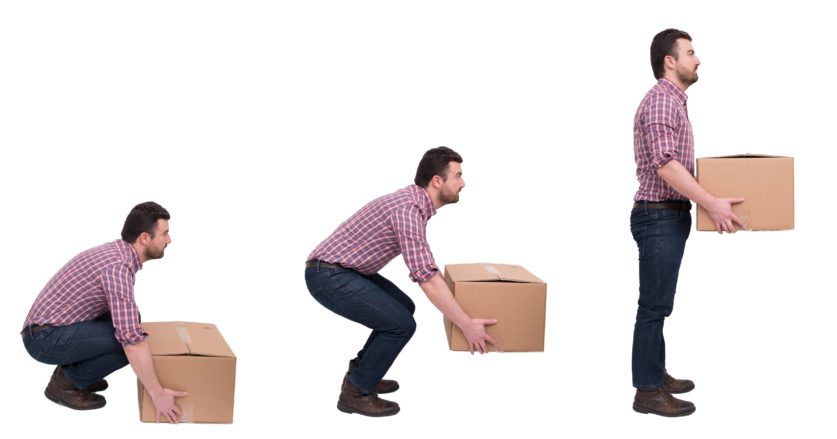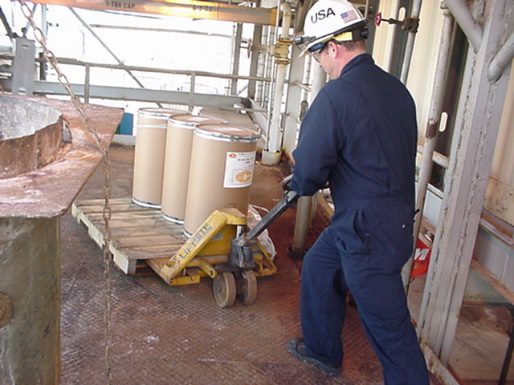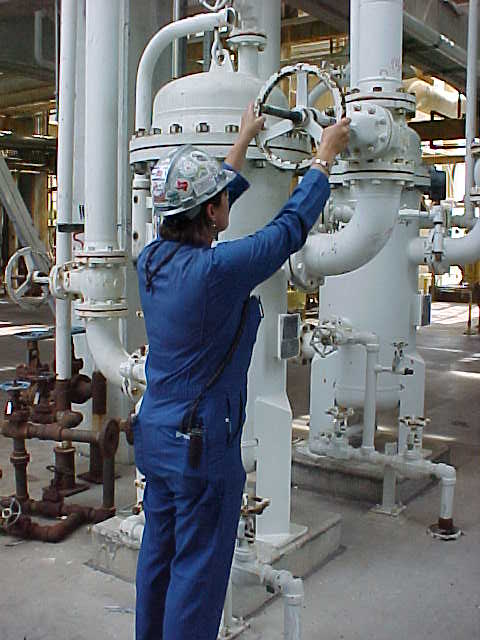Call Us Now1-800-414-2174


By Richard Bunch, PhD, PT, CBES and Trevor Bardarson, PT, OCS, CBES
Various publications have listed recommended weight limits for manual material handling. Based on the research used to develop the NIOSH lift equation, it is apparent that about 51 lbs represents the maximum weight that a single person can lift safely with two hands under optimal conditions. In the real world, however, optimum conditions as defined in the NIOSH Lift equation rarely exist. Consequently, limiting lifting and carrying to no more than 30 – 40 lbs (the lower the weight the better) are more reasonable ranges if true reduction in material handling injuries are desired. Any efforts to reduce weights and sizes of materials that are manually handled can be expected to result in a reduction of material handling injuries.
Proper Manual Lifting Technique
The best manual lifting technique has been debated for many years. However, there appears to be some common principles related to the safest way to manually lift an object.

Principle 1: Keep the load close.
Reducing the lever arm of the lift reduces disc compression forces in the spine.
Principle 2: During the lift, maintain the lower back in the neutral inward curve (the
“lordotic” position).
This is what is referred to by weight lifters as “locking in” the back. Maintaining the lower spine in the neutral position (i.e., the inward curve referred to as lordosis) requires contraction of trunk muscles that help stabilize the lumbar spine.
Principle 3: Use the legs to lift, not the back.
Lifting from the knee bent position with the back locked in neutral is essential. No one should ever lift by bending or flexing at the waist with the legs straight. The disc pressures are excessive and the trunk muscles cannot stabilize the lumbar spine in such a lift.
Principle 4. Tighten the abdominal muscles during the lift.
Tightening the abdominal muscles will help further stabilize the lumbar spine.
Principle 5. Lift slowly and smoothly.
The slower and smoother the lift, the better the muscular control. In addition, there is less of a spike in disc pressure when the lift is performed slowly as opposed to jerking. Internal forces in the spine increase in direct relationship to the acceleration of the lift (i.e., Force = mass x acceleration, or F = MA)
Principle 6. Avoid twisting while lifting.
It is well known that most lifting injuries occur with the trunk flexed and twisted. The spine is not designed for twisting while under loads. The risk is augmented by the fact that when the trunk is flexed, both back and abdominal muscle activity is greatly diminished. Avoiding twisting forces during a lift reduces the risk of injuring a muscle, disc, or joint in the spine.
Ergonomic intervention should be directed to eliminating any job task requiring frequent or prolonged trunk rotations or twisting motions.
Handling Materials on Shelves

How materials are stored on shelves can have an important impact on material handling injuries. Whenever possible, materials to be stored on shelves should be placed on pallets so that a forklift can be utilized to remove it.
When manual handling of stored materials is necessary, placing materials on shelves located between shoulder and upper thigh height (the power lift zone) for the average height employee will reduce the need for lifting from overhead or lifting from a low level. The use of an anthropometric table can be used for work design considerations. By using the 5th percentile data for women for shoulder height (124.09 cm or 49 inches) and the 95th percentile data for men for knuckle height (82.55 cm, or 32.5 inches), the shelves can be placed in a reasonably safe height range that will accommodate most employees.
Lifting materials from a low level, especially below 50.8 cm or 20”, is considered a high-risk lift task. The heaviest materials that are to be manually handled should be placed on the shelf closest to waist level and the lightest materials or materials least frequently handled at the highest and lowest shelves. In such cases, shelves should be secured to the wall to prevent the shelving system from falling over. When materials are stored haphazardly, employees will find it difficult to lift these materials safely using proper body mechanics.
Storage units that have deep shelves create a high risk for reaching and lifting injuries. In such situations, an angled, gravity-fed storage shelf system with roller ball shelves should be considered. This eliminates the need to bend and reach deep into the shelves to grasp materials and pull them forward.
Using rolling scissor lift carts that can be adjusted to match the various heights of the shelves is very beneficial. It is almost always preferable to push or pull a material onto a surface rather than to lift and place the material on a surface.
Angled, gravity-fed storage shelf systems with roller ball shelves should be replace storage shelf units that have deep shelves.
Carrying
The need to carry materials, in most cases, indicates poor ergonomic design. Carrying materials loads the spine similar to lifting, although back injuries are more frequent with lifting than carrying. This relates to the greater disc compression forces on the lower back during the initial phase of lifting. However, carrying does have definite risks, especially if done while climbing stairs or inclines. These risk factors include:
Heart attacks and strokes have been associated with carrying materials up and down stairs. The combination of using the legs to climb up stairs while using the arms to hold the material being carried (which of course is also a safety risk for falls), significantly elevates blood pressure and heart rate. Therefore, there is an increased risk of cardiovascular problems when carrying materials.
Carrying tasks should be eliminated whenever possible by mechanical assistive devices such as belt or roller conveyor systems, lift trucks, forklifts, motorized carts or handcarts, etc. Multi-directional ball roller conveyor belts can be used when materials need to be moved in a variety of directions. Whenever possible, mechanically operated elevators or hand operated pulley systems should be used to move materials vertically rather that carry materials when climbing stairs.
Manual carrying on the job, in most cases, indicates poor ergonomic design.
Proper Manual Carrying
If a material has to be carried manually, it should always be held as close to the body as possible (i.e., the same basic lever principle as applied when lifting). Many back and shoulder injuries that occur during carrying do not happen as a direct result of carrying, but as a result of a sudden change in biomechanical stress from reaching out with the load, twisting the trunk to maneuver the body, or shifting of the weight of the material causing a sudden asymmetrical load on the body.
The quality of coupling between the hands and the materials being carried is also important. Make sure that materials have good handles to avoid additional muscle fatigue to handle.
When carrying materials upstairs, it is best to place the material into a container or bag that has a strap which can be placed over one shoulder. This frees the arms and places less stress on the cardiovascular system. A hand can now be used to hold on to the stair railing for balance and support.
Pushing and Pulling

Pushing and pulling of materials are less risky than lifting. Approximately 20% of overexertion injuries are related to pushing and pulling.
Upper force limits for horizontal pushing and pulling can be found in publications such as Ergonomic Design for People at Work (1986), the work of Snook and Ciriello (1991) and A Guide to Manual Materials Handling by Mitral et al (1993). For example, while standing with the hands pushing or pulling between waist and shoulders, the recommended safe limit was determined to be 23 kg (50.6 lbs) of force.
Some key factors to consider related to pushing and pulling include:
Unlike lifting (which is typically measured by weight), pushing and pulling is measured in terms of initial peak force and sustained force using a push-pull measurement tool such as a dynamometer. It is generally accepted that peak forces should be less than 22.7 Kg (50 lbs) and sustained forces should be less than 11.4 Kg (25 lbs) for occasional push and pull forces whenever possible.
Manual pushing and pulling can be engineered out by the use of motorized pallet jacks, forklifts, or motorized conveyor belts. However, when moving materials on a cart manually, forces can be reduced by decreasing the weight of the materials being pushed or pulled, increasing the size of the cart’s wheels or casters, and keeping the wheels on the cart lubricated and clean.
It is also important to provide the best surface possible on which to move the cart. The surface should be level, and free of uneven surfaces, obstacles and barriers.
Unlike lifting (which is typically measured by weight), pushing and pulling is measured in terms of initial peak force and sustained force using a push-pull measurement tool such as a dynamometer.
Proper Handling of Valves

Valve positioning is very important. Ergonomic variables of valve design are:
The primary goals in valve design is to have the valve wheel or lever located with the safe vertical zone for most employees. The safe vertical distance is defined as the vertical distance between the upper thigh and shoulders. This the length of the valve may be adjusted to accommodate employees. Reduce reaching for valves by removing railing barriers or any other barriers that forces an employee to have to reach to turn the valve.
Push and pull forces required to handle valves can be reduced by lubricating the valve and/or increasing the length of a valve wrench for better leverage. Better access to valves by using scaffolding, fixed platforms, pull chains, or portable stairs may be required to permit a worker to handle the valve in the optimum body position without excessive reaching and awkward postures. Replacing difficult valves with motor operated valves (MOVs) is the ultimate engineering solution.
One of the primary goals in valve design is to have the valve wheel or lever located within the vertical distance between the upper thigh and shoulders. Push and pull forces on valves can be reduced by lubricating the valve and/or increasing the length of a valve wrench for better leverage.
Summary
The ultimate ergonomic intervention in material handling is to engineer out the material handling task. That being said, engineering out the problem is not always feasible. Proper training and enforcement of proper manual material handling is critical to help prevent musculoskeletal injuries that occur from material handling.
The ultimate ergonomic intervention in material handling is to engineer out the material handling task.
For more information on material handling methods or manual material training for employees, please call Dr. Bunch or Trevor Bardarson at WorkSaver: (800) 414-2174.
Interested in becoming certified as a Behavioral-Based Ergonomic Specialist (CBES)?
The unique CBES credentialing program is used nationally by ergonomic specialists, safety and occupational health professionals and integrates wellness interventions with the latest concepts in office and field ergonomic assessments. Check out our CBES credentialing program at www.CBES-ergonomics.com . Soon to be offered online!
WorkSaver Employee Testing Systems 478 Corporate Dr. Houma, LA 70360
![]()